The AMD Ryzen 9 5900X, with its 12-core, 24-thread configuration, remains a highly capable processor for demanding gaming, content creation, and multi-threaded workloads. To unlock its full potential, pairing it with a suitable motherboard is not just a recommendation; it’s a necessity. A motherboard dictates everything from power stability and cooling to connectivity and expansion capabilities. For those building a new system or considering when you should upgrade your motherboard, making an informed choice is critical.
This guide provides a purely informational, objective analysis of select AM4 motherboards compatible with the Ryzen 9 5900X. It focuses on verified specifications and features to help you understand which board aligns with specific user needs, from high-performance gaming to professional applications. The central question of do you need a good motherboard for gaming is particularly relevant here, as a robust board ensures the CPU performs optimally without thermal or power-related constraints.
Key Considerations for a Ryzen 9 5900X Motherboard
Choosing a motherboard involves understanding a few core technical aspects. These elements determine the performance, feature set, and longevity of your PC build.
Chipset Differences: X570 vs. B550
The primary chipset choices for the Ryzen 5000 series are the X570 and B550.
- X570: This is the enthusiast-grade chipset. Its main advantage is broader PCIe 4.0 support. X570 boards offer PCIe 4.0 connectivity from the CPU and the chipset itself, providing more high-speed lanes for multiple NVMe SSDs and expansion cards. Early X570 models required a small fan for chipset cooling, though later premium versions like the “X570S” feature passive cooling.
- B550: Positioned as the mainstream option, the B550 chipset offers excellent value. It provides a PCIe 4.0 x16 slot for the GPU and one PCIe 4.0 M.2 slot directly from the CPU. However, the lanes connecting from the chipset to other M.2 slots and PCIe slots are PCIe 3.0. For most users, including gamers, this is entirely sufficient. For a more detailed comparison, exploring a B550 vs X570 analysis can be beneficial.
VRM and Power Delivery: Fueling the 12-Core CPU
The Voltage Regulator Module (VRM) is arguably one of the most critical main components on the motherboard. It converts the 12V power from your PSU into the precise, lower voltage your CPU needs. A robust VRM with high-quality power stages and effective heatsinks is crucial for the Ryzen 9 5900X (105W TDP) to maintain its boost clocks, especially during sustained, heavy loads or overclocking. A board with a well-designed power delivery system will run cooler and provide more stable performance.
Motherboard Form Factors
The size of the motherboard, or its form factor, dictates case compatibility and expansion potential. Understanding the difference between Micro-ATX vs Mini-ITX vs ATX is key.
- ATX: The standard size, offering the most PCIe slots, RAM slots, and connectivity options.
- Micro-ATX (mATX): A shorter version of ATX, offering a balance of features and a smaller footprint.
- Mini-ITX (mITX): The smallest form factor, designed for compact builds. It typically has only one PCIe slot and limited expansion.
Essential Connectivity: PCIe 4.0, M.2, and Networking
For a modern system, robust connectivity is essential.
- PCIe 4.0: The Ryzen 9 5900X supports PCIe 4.0, offering double the bandwidth of PCIe 3.0. This benefits modern graphics cards and, most notably, Gen4 NVMe SSDs, which can achieve read/write speeds exceeding 7,000 MB/s.
- M.2 Slots: Knowing how many M.2 slots on a motherboard you need is important for fast storage. Aim for at least two, with one being PCIe 4.0 compatible.
- Networking: For wired connections, 2.5GbE LAN is becoming the standard over older 1GbE ports. For wireless, Wi-Fi 6 (802.11ax) or Wi-Fi 6E provides lower latency and higher speeds than previous generations, which is especially beneficial for users who do motherboards come with WiFi.
Comparison of Selected Motherboards for the Ryzen 9 5900X
This table offers a high-level overview of the key specifications for the motherboards detailed in this guide.
| Feature | ASUS TUF Gaming X570-Plus (Wi-Fi) | ASUS Prime X570-Pro | MSI MPG X570 GAMING EDGE WIFI | ASUS ROG Crosshair VIII Hero | ASUS TUF GAMING B550M-PLUS WiFi II | GIGABYTE X570 I AORUS Pro Wi-Fi | ASUS ROG Crosshair VIII Dark Hero | GIGABYTE B550 AORUS PRO V2 |
| Chipset | AMD X570 | AMD X570 | AMD X570 | AMD X570 | AMD B550 | AMD X570 | AMD X570 | AMD B550 |
| Form Factor | ATX | ATX | ATX | ATX | Micro-ATX | Mini-ITX | ATX | ATX |
| VRM/Power Stages | 12+2 Dr. MOS | 12+2 Dr. MOS | 8+2+1 Phases | 14+2 Power Stages | 8+2 Dr. MOS | 8-Phase Direct | 14+2 Power Stages | 12+2 Phases |
| Memory Support | 4x DDR4, 128GB | 4x DDR4, 128GB | 4x DDR4, 128GB | 4x DDR4, 128GB | 4x DDR4, 128GB | 2x DDR4, 64GB | 4x DDR4, 128GB | 4x DDR4, 128GB |
| PCIe 4.0 x16 Slot | 1 | 1 | 1 | 2 | 1 | 1 | 2 | 1 |
| PCIe 4.0 M.2 Slots | 1 | 1 | 1 | 2 | 1 | 2 | 2 | 1 |
| Total M.2 Slots | 2 | 2 | 2 | 2 | 2 | 2 | 2 | 2 |
| LAN Speed | 1GbE (Realtek) | 1GbE (Intel) | 1GbE (Realtek) | 2.5GbE + 1GbE | 2.5GbE (Realtek) | 1GbE (Intel) | 2.5GbE + 1GbE | 2.5GbE (Realtek) |
| Wi-Fi | Wi-Fi 5 | No | Wi-Fi 5 | Wi-Fi 6 | Wi-Fi 6 | Wi-Fi 6 | Wi-Fi 6 | No |
| Audio Codec | Realtek S1200A | Realtek S1220A | Realtek ALC1220 | ROG SupremeFX S1220 | Realtek ALC897 | Realtek ALC1220-VB | ROG SupremeFX S1220 | Realtek ALC1220-VB |
| Chipset Cooling | Active (Fan) | Active (Fan) | Active (Fan) | Active (Fan) | Passive | Active (Fan) | Passive | Passive |
Detailed Analysis of AM4 Motherboards for the Ryzen 9 5900X
Here we provide a more in-depth look at each motherboard, focusing on its specific strengths and ideal use cases with the Ryzen 9 5900X.
ASUS AM4 TUF Gaming X570-Plus (Wi-Fi)
The TUF Gaming X570-Plus has been a long-standing popular choice in the X570 category, offering a balanced feature set for mainstream and gaming-focused builds.
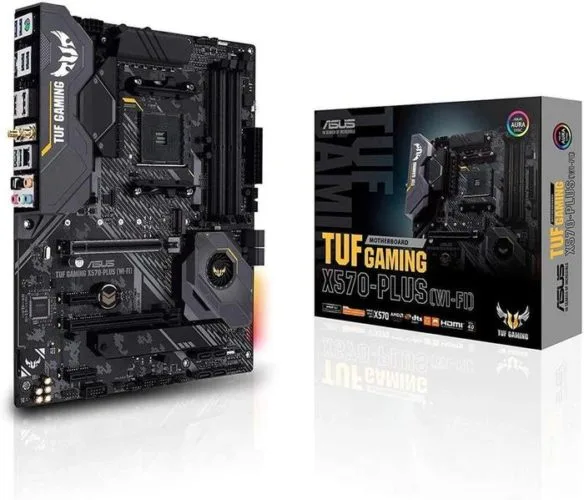
Core Specifications
- Chipset: AMD X570
- Form Factor: ATX
- Power Delivery: 12+2 Dr. MOS power stages
- Connectivity: 1x PCIe 4.0 x16, 1x PCIe 4.0 M.2, 7x USB 3.2 ports (Type-A/C)
- Networking: Realtek L8200A 1GbE LAN, Intel Wi-Fi 5 (802.11ac)
Performance and Power Delivery
The 12+2 power stage design is robust enough to handle the Ryzen 9 5900X at stock speeds and allows for moderate overclocking. The VRM heatsinks are substantial, ensuring good thermal performance under load, which is critical for maintaining stable boost clocks.
Connectivity and Expansion
It offers a solid baseline of X570 connectivity, including a primary PCIe 4.0 slot for a GPU and a high-speed M.2 slot for a boot drive. While it features Wi-Fi, it is the older Wi-Fi 5 standard, and the LAN is limited to 1GbE, which may be a consideration for users with high-speed home networks.
Viability
This board remains a viable budget-conscious X570 option. However, its active chipset fan, 1GbE LAN, and Wi-Fi 5 are dated compared to newer B550 and X570S models. It is suitable for users who want the full PCIe 4.0 capabilities of X570 without the cost of premium boards.
ASUS Prime X570-Pro
The Prime X570-Pro targets a more professional or creator-oriented audience with its clean, white-and-silver aesthetic and focus on stability and connectivity.
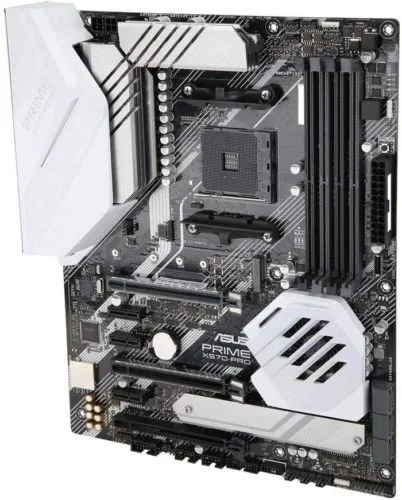
Core Specifications
- Chipset: AMD X570
- Form Factor: ATX
- Power Delivery: 12+2 Dr. MOS power stages
- Connectivity: 1x PCIe 4.0 x16, 1x PCIe 4.0 M.2, 8x USB 3.2 ports (Type-A/C)
- Networking: Intel I211-AT 1GbE LAN
Performance and Power Delivery
Sharing a similar VRM design with the TUF Gaming model, the Prime X570-Pro delivers reliable power to the Ryzen 9 5900X. It’s well-suited for long, sustained workloads like video rendering, where power stability is key.
Connectivity and Expansion
The board offers a strong array of USB ports and expansion slots. Its main drawback is the lack of onboard Wi-Fi and a 2.5GbE LAN port. Users requiring wireless connectivity would need to purchase a separate adapter. The Realtek S1220A audio codec is a step up from the one on the TUF board.
Viability
This model is a solid choice for productivity builds where aesthetics are a factor. Its main limitations are the active chipset fan and dated networking. For a system built around a powerful CPU like the best cpu for rtx 3070, users might prioritize faster networking found on other boards.
MSI MPG X570 GAMING EDGE WIFI
This motherboard was one of MSI’s initial mainstream offerings for the X570 platform, aimed squarely at gamers.
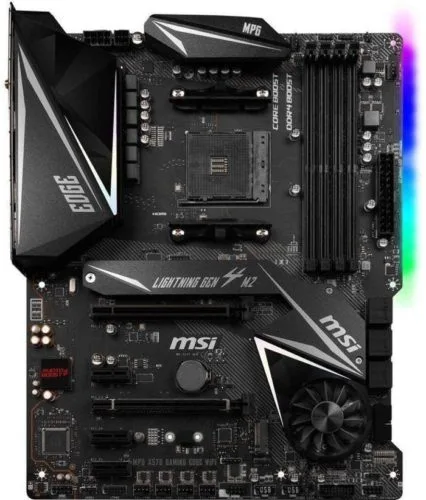
Core Specifications
- Chipset: AMD X570
- Form Factor: ATX
- Power Delivery: 8+2+1 Phase design
- Connectivity: 1x PCIe 4.0 x16, 1x PCIe 4.0 M.2, 7x USB 3.2 ports (Type-A/C)
- Networking: Realtek 8111H 1GbE LAN, Intel Wi-Fi 5 (802.11ac)
Performance and Power Delivery
The VRM on this board is less robust than the ASUS offerings and is better suited for running the Ryzen 9 5900X at stock settings. While functional, it may not provide significant headroom for aggressive overclocking.
Connectivity and Expansion
It offers a standard X570 feature set, including PCIe 4.0 support for the GPU and one M.2 drive. Like other early X570 boards, its networking is limited to 1GbE LAN and Wi-Fi 5.
Viability
Largely Superseded. While functional, the MPG X570 GAMING EDGE WIFI has been effectively replaced by MSI’s X570S series (e.g., MPG X570S EDGE MAX WIFI), which feature superior fanless chipset cooling and often include 2.5GbE LAN. Unless found at a significant discount, most users would be better served by a newer B550 board or an X570S alternative.
ASUS ROG Crosshair VIII Hero (X570)
The Crosshair VIII Hero is a premium, enthusiast-grade motherboard from the Republic of Gamers (ROG) line, packed with high-end features for overclocking and gaming.
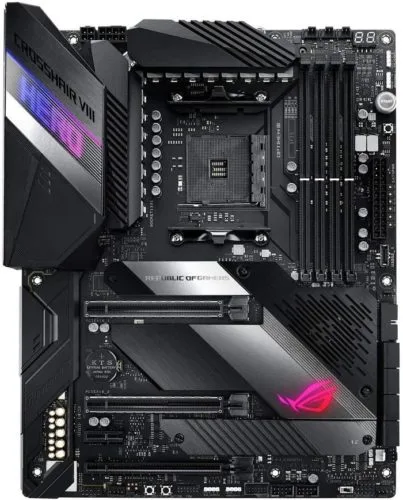
Core Specifications
- Chipset: AMD X570
- Form Factor: ATX
- Power Delivery: 14+2 teamed power stages
- Connectivity: 2x PCIe 4.0 x16 (run at x8/x8), 2x PCIe 4.0 M.2, 12x USB 3.2 ports
- Networking: Realtek 2.5GbE LAN, Intel 1GbE LAN, Intel Wi-Fi 6
Performance and Power Delivery
With a formidable 14+2 power stage design and massive heatsinks, the Crosshair VIII Hero is engineered to push high-core-count CPUs like the 5900X to their limits. It provides exceptionally stable power for aggressive overclocking.
Connectivity and Expansion
This is a key strength. It features dual PCIe 4.0 M.2 slots, extensive USB connectivity, and high-performance networking with both 2.5GbE LAN and Wi-Fi 6. It also includes numerous enthusiast-friendly features like onboard power buttons, a POST code display, and voltage monitoring points.
Viability
This remains a powerful and feature-rich motherboard. However, like other early models, it uses an active chipset fan. Its successor, the Dark Hero, addresses this. It’s an excellent choice for enthusiasts who can find it at a reasonable price, but it often competes with its own passively cooled successor. Before installation, it’s always wise to learn how to install motherboard drivers to ensure full functionality.
ASUS TUF GAMING B550M-PLUS WiFi II
A Micro-ATX board that demonstrates the strength of the B550 chipset, offering modern features in a more compact and affordable package. The “WiFi II” is a welcome refresh.
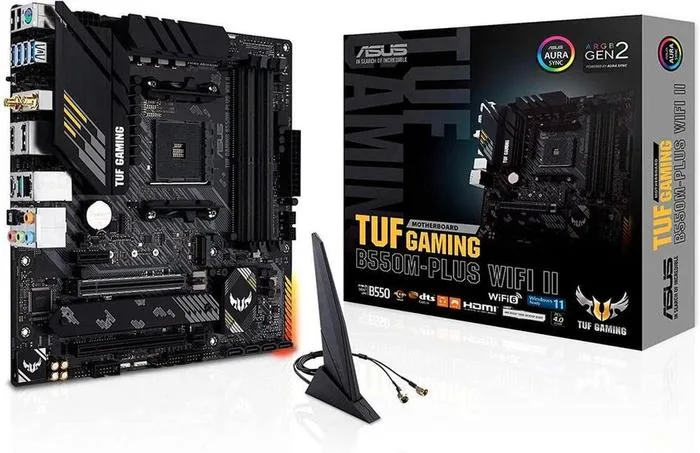
Core Specifications
- Chipset: AMD B550
- Form Factor: Micro-ATX
- Power Delivery: 8+2 Dr. MOS power stages
- Connectivity: 1x PCIe 4.0 x16, 1x PCIe 4.0 M.2, 6x USB 3.2 ports
- Networking: Realtek 2.5GbE LAN, Wi-Fi 6
Performance and Power Delivery
The 8+2 Dr. MOS power delivery is well-equipped to handle the Ryzen 9 5900X, especially at stock speeds or with mild overclocking. The VRM heatsinks are effective for a board in this class, making it a reliable choice for a powerful yet compact build.
Connectivity and Expansion
For a Micro-ATX board, the feature set is impressive. It includes 2.5GbE LAN and Wi-Fi 6, features often reserved for more expensive ATX boards. It provides the essential PCIe 4.0 support for a GPU and primary NVMe SSD.
Viability
This is an excellent choice for users wanting to build a powerful, smaller-form-factor PC around the 5900X without unnecessary expense. Its modern networking and robust VRM make it a top-tier value proposition in the B550 space.
GIGABYTE X570 I AORUS Pro Wi-Fi
A Mini-ITX motherboard that proves high performance can come in small packages. It’s a favorite for small form factor (SFF) enthusiasts who refuse to compromise on power.
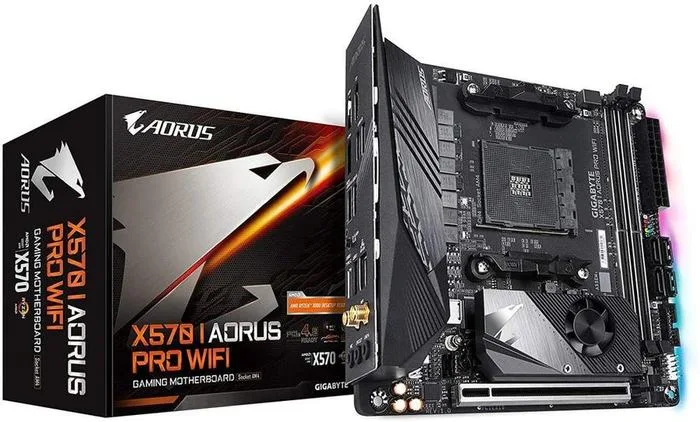
Core Specifications
- Chipset: AMD X570
- Form Factor: Mini-ITX
- Power Delivery: 8-phase direct digital VRM
- Connectivity: 1x PCIe 4.0 x16, 2x PCIe 4.0 M.2, 6x USB 3.2 ports
- Networking: Intel 1GbE LAN, Intel Wi-Fi 6
Performance and Power Delivery
Despite its small size, this board features a very strong direct 8-phase VRM with a 70A power stage, making it more than capable of handling a stock or overclocked Ryzen 9 5900X. The thermal design is clever, with a multi-layered heatsink to manage temperatures in a cramped environment.
Connectivity and Expansion
Its most impressive feature is providing two PCIe 4.0 M.2 slots on a Mini-ITX board (one on the front, one on the back), a feat many larger boards don’t achieve. This allows for an extremely fast, all-SSD SFF build.
Viability
For SFF builders, this remains one of the best AM4 options. Its only minor drawbacks are the 1GbE LAN and the active chipset fan. Given its unique capabilities, it continues to be a highly relevant and sought-after motherboard.
ASUS ROG Crosshair VIII Dark Hero
The Dark Hero is the refined version of the original Crosshair VIII Hero, addressing its main drawback by implementing a large, passive chipset heatsink.
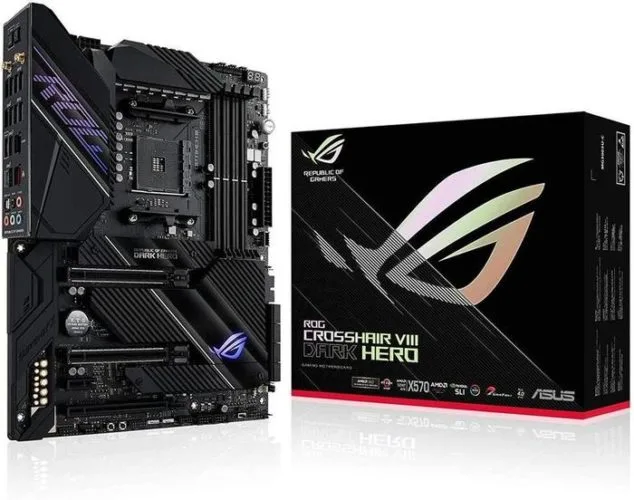
Core Specifications
- Chipset: AMD X570
- Form Factor: ATX
- Power Delivery: 14+2 teamed power stages (90A)
- Connectivity: 2x PCIe 4.0 x16 (run at x8/x8), 2x PCIe 4.0 M.2, 12x USB 3.2 ports
- Networking: Realtek 2.5GbE LAN, Intel 1GbE LAN, Intel Wi-Fi 6
Performance and Power Delivery
The Dark Hero’s power delivery is elite-tier, designed for extreme overclocking and ensuring absolute stability for the 5900X under any load. The key upgrade, however, is the fanless chipset cooling, which eliminates a potential point of failure and noise source.
Connectivity and Expansion
It carries over the exceptional connectivity of its predecessor, including dual LAN, Wi-Fi 6, dual PCIe 4.0 M.2 slots, and a massive number of USB ports. It also introduces Dynamic OC Switcher, a feature allowing the system to automatically switch between single-core and all-core overclocks.
Viability
This is arguably one of the best X570 motherboards ever made. It combines a top-tier feature set with silent, passive cooling. While it carries a premium price and availability may be limited, it represents the peak of the AM4 platform for users who want the absolute best without compromise. An important step after getting such a board is knowing how to update the motherboard BIOS to ensure support and stability.
GIGABYTE B550 AORUS PRO V2
A full-featured ATX B550 motherboard that offers a significant portion of the enthusiast experience at a much more accessible price point.
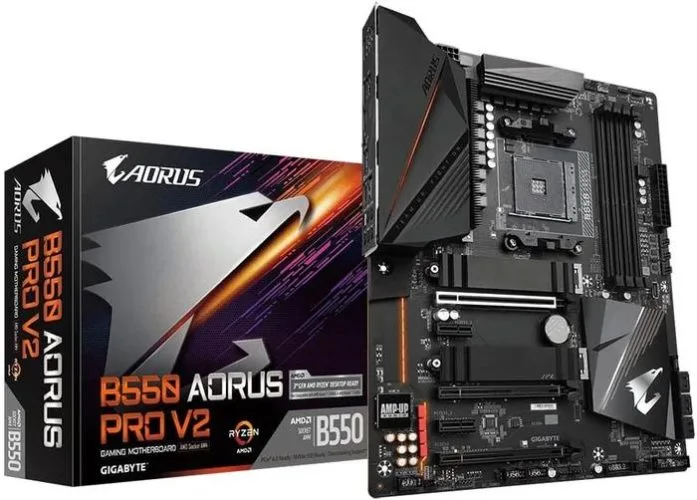
Core Specifications
- Chipset: AMD B550
- Form Factor: ATX
- Power Delivery: 12+2 phase digital VRM
- Connectivity: 1x PCIe 4.0 x16, 1x PCIe 4.0 M.2, 6x USB 3.2 ports
- Networking: Realtek 2.5GbE LAN
Performance and Power Delivery
The 12+2 phase VRM is very strong for a B550 board and handles the Ryzen 9 5900X with ease, providing plenty of clean power for stable operation and overclocking. The large heatsinks ensure the power delivery components remain cool.
Connectivity and Expansion
This board delivers on modern essentials with a 2.5GbE LAN port and excellent ALC1220-VB audio. It features two M.2 slots (one Gen4, one Gen3) and ample SATA ports for storage. The lack of built-in Wi-Fi is a key differentiator from more expensive models.
Viability
The B550 AORUS PRO V2 is an excellent, high-value ATX motherboard for the Ryzen 9 5900X. It provides the core performance and features most users need—a strong VRM, PCIe 4.0 for the GPU/SSD, and fast networking—without the expense of the full X570 feature set. It’s a perfect example of why B550 is a smart choice for many builders.
Frequently Asked Questions (FAQ)
What is the best chipset for the Ryzen 9 5900X?
For most users, including gamers and general-purpose builders, the B550 chipset offers the best combination of performance, features, and value. It provides the essential PCIe 4.0 support for the primary graphics card and NVMe SSD. The X570 chipset is better suited for enthusiasts or professionals who require PCIe 4.0 connectivity across multiple M.2 and expansion slots simultaneously.
Do I need to update the motherboard BIOS for a Ryzen 9 5900X?
Most B550 and X570 motherboards manufactured after the launch of the Ryzen 5000 series will ship with a compatible BIOS. However, if you acquire older stock, a BIOS update might be necessary. Many motherboards feature a “BIOS FlashBack” function that allows you to update the BIOS using only a USB drive and power supply, without a CPU installed. It is always advisable to check the manufacturer’s CPU support list for the specific board model.
Is a B550 motherboard sufficient for a Ryzen 9 5900X?
Yes, absolutely. A quality B550 motherboard with a robust VRM (e.g., 8+2 power stages or better) and adequate heatsinks is perfectly sufficient to run the Ryzen 9 5900X at its full potential, including moderate overclocking. The primary trade-off is fewer PCIe 4.0 lanes from the chipset, which does not impact gaming performance or primary drive speed.
What kind of RAM is most suitable for a Ryzen 9 5900X?
The Ryzen 9 5900X benefits greatly from fast DDR4 memory. The optimal configuration is typically a dual-channel kit (2x16GB or 2x8GB) with speeds between 3600MHz and 4000MHz and low latency (CL16 or CL18). This speed range aligns well with the processor’s Infinity Fabric clock for optimal performance. For a dedicated guide, see this resource on the best RAM for Ryzen 9 5900X.
Can the Ryzen 9 5900X be used on an A520 motherboard?
While technically possible with a BIOS update on some models, it is not recommended. A520 is an entry-level chipset with basic power delivery systems that are not designed to handle the power requirements of a 12-core, 105W TDP processor like the 5900X. This pairing would likely result in the CPU being power-throttled and unable to reach its full performance potential.
Does the Ryzen 9 5900X support PCIe 5.0?
No. The Ryzen 9 5900X and the entire AM4 platform are limited to the PCIe 4.0 standard. PCIe 5.0 support was introduced with AMD’s newer AM5 socket and Ryzen 7000 series processors.

Holding a Ph.D. in Computer Science, Dr. Alistair Finch is our chief PC Component Benchmark Analyst. He provides meticulous, data-driven analysis of CPUs and GPUs, moving beyond marketing claims to reveal their true performance. His guides help readers understand the intricate relationship between hardware architecture and real-world gaming frame rates.
